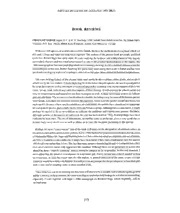
Book review: Frogs of Sabah. R.F. Inger & R.B. Stuebing. 1990. Sabah Parks Publication No. 10. Sabah, 132 pp PDF
Preview Book review: Frogs of Sabah. R.F. Inger & R.B. Stuebing. 1990. Sabah Parks Publication No. 10. Sabah, 132 pp
FROGS OFSABAH. Inger, R.F.&R.B.Stuebing. 1990.Sabah Parks Publication No. 10,Sabah Parks Trustees, P.O. Box 10626,88806 Kota Kinabalu, Sabah, East Malaysia. 132pp. With over 100species ofanurans known from Sabah, Borneo, the publication ofalayman's book on this state's frogs and toads has long been expected. The authors ofthe present book are amply qualified to do this. Robert Inger has spent some 40 years studying the herpeto- and ichthyofauna of this region, particularly Borneo, and has established himself asone ofthe premier herpetologists ofthe region. His 1966monograph onBornean amphibia which heiscurrently revising, isstillastandard reference text for herpetologists inthis area. Robert Stuebing has spent many years doing field work inSabah and hasbeen involved inecological studies ofvertebrates, which inrecent years, havecentred onSabahan herpetofauna. The most striking feature ofthe present book must surely be the excellent colour plates, almost all of which are bythetwo authors. Clearly depicting 56ofthemore common species; thetext isaccompanied by crisp descriptions with aminimum oftechnical jargon but including very useful snippets oftheir life cycle, larvae, food, calls (ifany) and other aspects oftheir biology. Itwill certainly be abook useful not only to herpetologists and naturalists but field ecologists aswell. Amost interesting section on folklore precedes thebook. The section onclassification isvaluable, including akeyformost oftheknown species from Sabah, even those nottreated indetail bythemaintext. Akeytoallthespecies would havebeeneven more useful. Incases where species complexes areconsidered, theauthors have chosen nottoenumerate thecomponent species, particularly forthedifficult Philautus group. Although thisisconvenient, itmight perhaps be useful to do so nevertheless to indicate the problems and known taxa present. Similarly, although authors ofthe species areindicated, theyear has been omitted. They should perhaps have been indicated atleast once. This bit ofinformation, decried by many asirrelevant, gives avery good idea as tohow many were recent taxa aswell asallows ustotrace the literature pertaining tothe species. Perhaps themost "controversial" part ofthebook will surely bethedesignation ofcommon names, as theauthors themselves admit intheirpreface. Kiew(1984) hadearlier proposed alistofnames fortheanura ofPeninsular Malaysian. IngerandStuebing however, havechosen toadoptacompletely newsetofnames, and this isbound tocreate confusion. Itmight have been better ifthey had coined names only forspecies which had none rather than intoto. Thefactthatmany amateur herpetologists andviviculturists have their own setofcommon names only aggravates thesituation. Although there arenoguidelines astohow this should be done; "smooth-sounding" names should be adopted asfar aspossible. Inthis task however, I must admit that the amateur viviculturists do afar better job. Sorely missed was amuch needed section on references, at least the major ones for this region. A general selection of the more recent relevant literature would havebeenveryhelpful. Itwould provide anyprospective herpetologist orserious biologist with avery useful stepping-stone tomore detailed work. There however, canbenodenying thatthisbookwillprove tobeavaluable toolinenhancing thegeneral public's interest inthese animals. Itsvalue toecologists andother fieldbiologists willalsobeoutstanding, especially if used together with Inger's 1966 monograph on Bornean frogs, which hopefully, will be revised soon. Inger, R.F., 1966.The systematics andzoogeography oftheamphibia ofBorneo. Fie/diana, Zoo/., 52: 1- 402. Kiew, B. H., 1984. Conservation status of the Malaysian Fauna. Ill. Amphibians. Ma/ay. Nat., Kuala Lumpur, 37(4): 6-10. Peter K. L. Ng Department ofZoology, National University of Singapore, Kent Ridge, Singapore 0511, Republic of Singapore. THE FRESH-WATER FISHES OF NORTH BORNEO. Inger, R.F. &P. K. Chin. 1990.Fieldiana: Zoology, Volume 45 (1962). Reprinted bySabah Zoological Society, Sabah, Malaysia, with supplemen- tary chapter by P.K. Chin, 268+SC47 pp. The reprinting and updating of this important ichthyological publication is welcomed and timely, especially considering the growing interest inSoutheast Asian freshwater fishes. Since 1962, Inger and Chin's book has served asakey reference texttonotonly thefreshwater fishes ofSabah (=British North Borneo), but also for the rest of Borneo and other parts oftropical Southeast Asia aswell. The first 268 pages ofthebook isidentical tothe original publication bythe Chicago Natural History Museum which isnow outofprint. The last47 supplementary pages written by Datuk Chin Pui Kong is intended toupdate and include species described ordiscovered since 1962.46newfigures have alsobeen added to the 120 in the previous addition. The many new figures, mostly of species not dealt with or illustrated inthe original publication, are of ahigh quality and should prove most useful. This includes species like Wallago macu/atus Inger &Chin which has never been illustrated before. Intotal, 85native and 12introduced food species areconsidered, 56ofwhich areendemic toSabah orBorneo. Despite the scope oftheinvestigations intoSabahan freshwater fishfauna overtheyears, itisapparent thatmuch more remains tobedone. Chin has added 10species, mostly gastromyzontids, totheir 1962listoffishes. The fish fauna ofmany parts of Sabah however, despite theextensive studies ofInger and Chin, still remain poorly oreven unsampled, and the number ofknown species can be expected to increase still further in the coming years. The single weakness ofthenewedition ofthisbook must surely beinthetaxonomy andnomenclature. While the second author has attempted to update the book with new species and records in his supplementary chapter, itisapparent thathehasonlyconsidered theliterature pertaining directly toSabah. This selectivity isaproblem because thestateoffishtaxonomy hasprogressed agreatdealsincethe 1960s, andthefailure torefer toorutilise modem taxonomic/nomenclatural changes affects theusefulness ofthe book. Many groups have been revised between 1962 and 1990, e.g. the cobitids and balitorids (= homalopterids) (Sawada, 1982;Kottelat, 1984, 1987, 1988),barbins (Rainboth, 1981;Banarescu, 1986), channids (=ophicephalids) (Myers & Shapovalov, 1931); cichlids of the Tilapia complex (Trewawas, 1983)etc.While itmust begranted thatsupraspecific classifications areoften subjective, tofollow adated taxonomy without comment orexplanation canbevery confusing andreduces thevalue ofthebook. This isespecially inviewoftheseveral regional ichthyological books which havebeenreleased since 1962(e.g. Alfred, 1966;Mohsin &Ambak, 1983;Kottelat, 1989;Roberts, 1989;Urn &Ng, 1990)which useamore modern system ofclassification. Itwould have been better ifacompletely new edition ofthe book had been prepared, with thenew information and figures incorporated inthemain text forsmoother flow and
